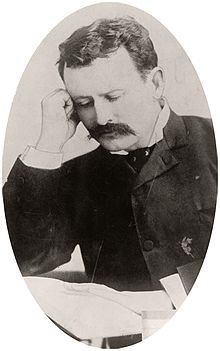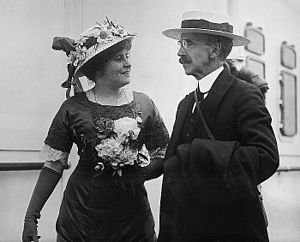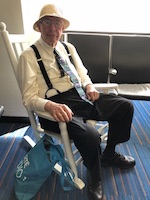In 1870, John Brisben Walker, founder of the Berkeley neighborhood, bought 1,500 acres south of Berkeley Park to West 38th Avenue, Sheridan Boulevard to Rocky Mountain Park up to West 52nd Avenue and Federal Boulevard.

Having been educated by the Jesuit Fathers back east, Walker donated 40 acres to the Jesuits who came to Denver from Naples, Italy. He wanted a college in his town of Berkeley. The Jesuits christened their college Sacred Heart, now named Regis University.
In 1885, Walker built a beautiful mansion on West 34th Avenue and Newton Street out of Indiana limestone brought to Denver’s Union Station by train. In the late 1880s, Walker sold what was left of his Berkeley farm for $325,000 to a Kansas City syndicate that continued developing the farmland.
The post office and Berkeley town hall were located on the southeast corner of West 45th Avenue and Yates street. The Berkeley municipal building was a small, stately, plump two-story building, which has recently been scraped-off.
In the early 1970s, when I was door-belling to be state representative, I knocked on the door of Mrs. Jones on the first floor and noticed a second Mrs. Jones occupying the second story of the old city hall. “Are you related to the Mrs. Jones upstairs?” I asked the woman who answered. “Yes, that is my late husband’s second wife,” she answered, adding that they were on good speaking terms. I asked both for their support.
Walker stayed around to develop many other imaginative and challenging projects in and around Denver, not like the slam-bam ‘see ya later’ developers treading across our city today.

On July 4, 1887, he opened Riverfront Park and Castle of Commerce down in the Platte Valley. Roughly 2,000 people showed up to get in on the roasted ox that Walker offered to visitors at the opening. The castle hosted bicycle races, sports events, horse races, winter ice skating, toboggan races, musical events and even a Roman three-horse chariot race. Walker’s Riverfront Park and Castle of Commerce was the original Denver Center for the Performing Arts. The Union Pacific Railroad bought it from Walker for $1.2 million in 1891. The castle burned down in the mid-1950s and the city used much of the old castle walls to bolster the banks of the Platte River.
In 1893, Walker turned his attention to the magazine he purchased, Cosmopolitan Magazine. He ran the magazine for 12 years and his reputation as a political, cultural and literary leader surged. He wrote articles for the publication and his voice became the voice for popular culture during the early 1900s. He sold the magazine to William Randolph Hearst in 1905 for $1 million and headed back to Colorado. His history of the magazine sells for over $1,000 on ebay.
According to his great-granddaughter, Erika Walker, in her wonderful book “Denver’s Mountain Parks: 100 Years of the Magnificent Dream”, between 1905 and 1910, the Walker family purchased more than 4,000 acres of real estate in and around the town of Morrison, Colo. Walker built a mansion that he hoped to offer to the president as a summer White House, but the building burned down in 1918.

In the Denver Post in 1910, Walker said of Denver: “Denver is a pretty city, I grant you, but people who come here from the Atlantic seaboard and from the prairies of the middle west do not come to look at handsome buildings and well-kept streets. They come here to see the marvelous mountain scenery they have heard and read so much about. And when they get here they find so many difficulties in the way of reaching this scenery that they quickly become discouraged and rush off to Colorado Springs or somewhere else, where the people have improved the splendid gifts nature has placed within their reach.”
Today, Walker would be appalled at the ugly developments popping up across our city, especially in his beloved Berkeley farm bedroom suburb. And he would complain bitterly about the many potholes lacing our city streets.
In his final years, Walker fought to convince city leaders to acquire mountain lands west of the city for parks for the people. The Denver Post lauded Walker for his imaginative future thinking. He worked to help the city acquire Red Rocks Park, which is the diamond in the crown of Denver’s Mountain Park system. The system today boasts 22 developed parks and 24 conservation areas.
“The most extensive and magnificent system of parks by any city in the world, covering eight square [miles] and including 41,000 acres, running from Turkey Creek Cañon on the south to Mount Vernon Cañon on the north, with Bear Creek Cañon about in the center, all within about 10 miles of the city… That is the amazing plan conceived by John Brisben Walker,” wrote the Denver Post in 1910.
We need more visionary leaders like Walker. The students at Regis University showed their gratitude for his generosity for donating the land on which Regis stands by naming the college’s pub after Walker.
The Honorable Dennis Gallagher is a former city auditor, city councilman, state senator and state representative sharing thoughts and stories from North Denver’s past and future.

Wonderful story Dennis and well told.
Fine article, Dennis. History, commentary on Denver today, humor — the great story about the two Mrs. Jones.
So it says in this article that Walker built the Summer House, but that it burned down in 1918. That is incorrect according to the history I’ve read. The summer house was never actually constructed, only a foundation, wall and cornerstone were erected because the project lacked funding. Also, it was Falcon Castle, Walker’s mansion that was built on Mt. Falcon, that was the structure that supposedly burned from a lightening strike in 1918. The remains of both can be accessed today.